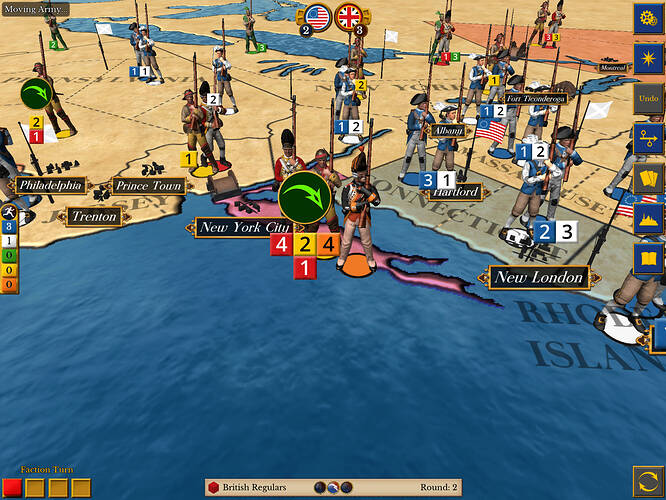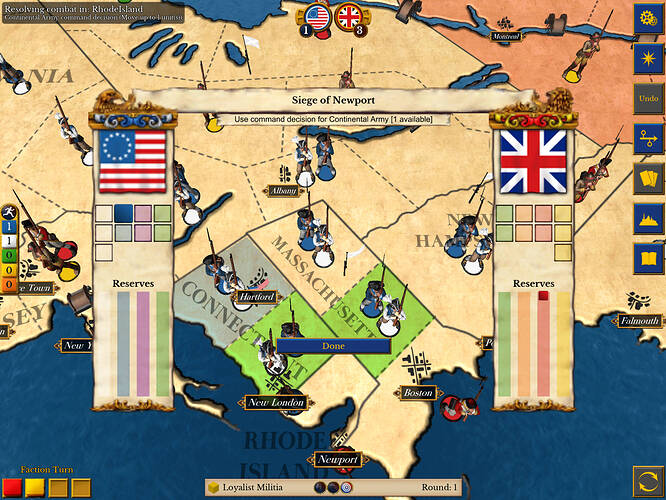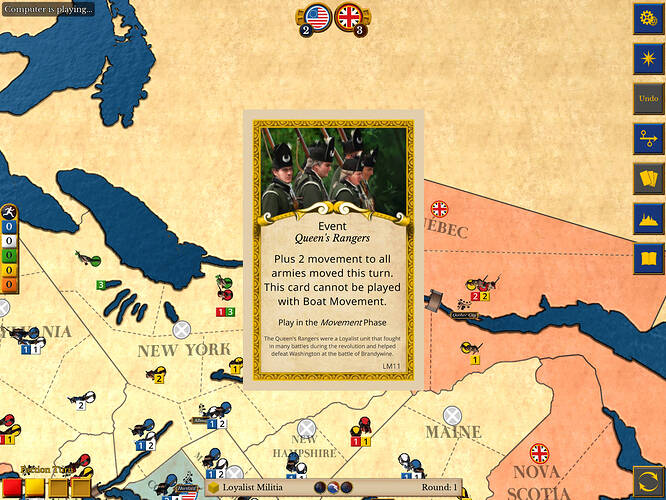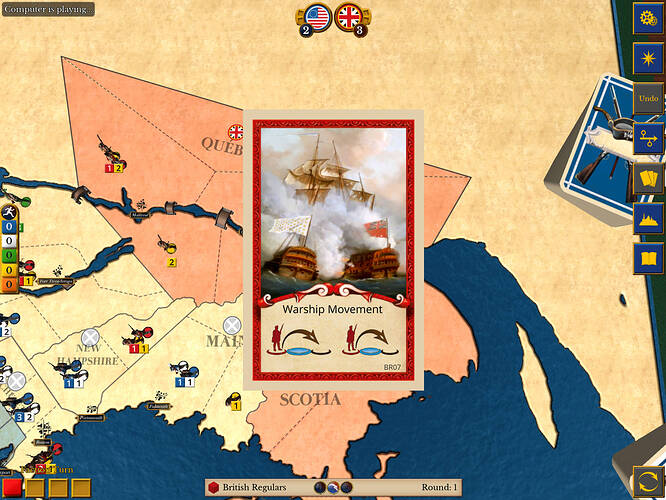Originally published at: http://statelyplay.com/2016/11/11/review-1775-rebellion/
1775: Rebellion is a simulation of the American revolutionary war against the British. It’s a subject tackled many times in gaming, but rarely with such startling simplicity as this. Originally a board game, it wowed players with its rare mixture of approachability and depth. Now it’s come to your iPad and Android tablet via a PC version.
That reputation for ease of play is well deserved. Each round you add some reinforcements to the map, play a card to determine how many armies can move and how far, and resolve battles with a few dice rolls. There is little else to learn. Indeed, when I grasped how simple the game was, I found it hard to imagine it could possibly be any good.
[caption id=“attachment_294” align=“aligncenter” width=“2048”]
Reinforce this.[/caption]Yet in spite of the brevity of rules, or perhaps because of it, this adaptation doesn’t offer a tutorial. In fact it exacerbates the omission by giving players the illusion of one, in the form of occasional pop-ups. However, the aim of these is to show how the digital version implements the rules, not to teach them. Those new to the game, like me, won’t find this out until they’ve stumbled around icons and menus in confusion for a quarter hour. The text rules are in the game, and easy to digest, but it’s still a bad start.
Armed with some understanding of what you’re doing, you can begin to experiment. And here 1775 begins to reveal why its original version was such a success.
The design is full of neat mechanical flourishes that subsume historical detail with almost zero overhead. There’s no better example than the battle system. Each of the four sides in the game, plus potential allies like the French and Native Americans, has their own set of coloured dice. There’s a fixed number for each faction, and that’s the most they can roll in a fight no matter how many units are involved. Right there you’ve got a super-simple way to mimic differences in training and command doctrine.
[caption id=“attachment_295” align=“aligncenter” width=“2048”]
Fight! Fight! Fight![/caption]There’s more cleverness to come. Dice results mean a unit either hits its target, flees or has a “command decision” which means the owner can move it or leave it put to fight. Again, the different factions have different dice. So British troops, for example, never flee. That gives yet more historical flavour and adds player agency to an otherwise random battle step.
Much of the rest of the depth and detail come from making tactical decisions on the board concerning what to move and where. Victory means taking and securing territory from the enemy, and there are multiple viable options. There are also powerful event cards mixed in to the movement deck which can swing the game back and forth. It’s a pitch-perfect balance of thrilling chaos and careful tactics.
[caption id=“attachment_296” align=“aligncenter” width=“2048”]
It’s the Kelly Keagy/Freddie Mercury mashup we’ve always wanted.[/caption]While the implementation looks nice at first, it sometimes impedes enjoyment of the mechanics beneath. That lack of a tutorial is an example. It’s full of slow and poorly animated sprites. There are some minor display bugs and the odd crash. There was a problem with the map zoom, which got fixed in an update part-way through my review plays. While it’s good to see the developer responding, it’s worrying something so basic was in the original release. Without the fix it was hard to do essential things like assign units to the right space.
During solo play, the AI exhibits some most peculiar behaviour. Most of the time it makes reasonably sensible plays. Then, once in a while it’ll make an attack against suicidal odds, wasting a move and the units involved. Even when firing on all cylinders it seems unlikely to challenge a veteran of the board game. Neophytes may find slowly upping the difficulty levels an enjoyable way to experiment with the strategy.
[caption id=“attachment_297” align=“aligncenter” width=“2048”]
I’m on a boat.[/caption]For those veterans there are multiplayer modes allowing them to play against other humans. It’s a good fit for pass and play mode, if that’s you’re thing. If not there is asynchronous - and only asynchronous - multiplayer courtesy of developer HexWar’s own matchmaking system. Right now the lobby is a ghost town. But if you’re patient you can post a game and someone will come along and join in.
On the whole, 1775: Rebellion provides a solid platform to showcase the original board game. However, given that it’s at the premium end of premium game pricing, it’s questionable whether it offers value for money. With bugs, limited AI strength and a multiplayer echo chamber, it’s unlikely to see an enormous amount of replay. Whether those are worthwhile deficiencies for the opportunity to play this great game is up to you.



